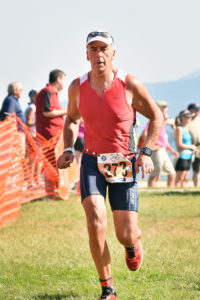By Daniel Dunaief
In medieval times, armies needed to understand the structure of the castles they were about to attack. Enough information could enable a leader to find a weakness and exploit it, giving his troops a plan to take over the castle. Today, researchers use advanced tools to study the molecular structure of everything from tumors to the protein plaques involved in neurodegenerative conditions like Alzheimer’s disease.
Recently, William Van Nostrand and Steven Smith, scientists at Stony Brook University who have worked together for over 10 years, discovered subtle differences in amyloid fibril structures that surround blood vessels and neurons. Many forms of the structures likely have some contributory effect to cognitive declines, although researchers debate the extent of that contribution, Van Nostrand said.

Amyloid fibrils in plaques in the space between neurons have subunits lined up side by side in a head-to-head manner. Van Nostrand and Smith’s new work, which was published in Nature Communications, showed that vascular amyloid subunits, which are on the vessel’s surface, have a different configuration, lining up side by side in an alternating head-to-toe pattern.
This structural difference generates a new set of questions that might provide insight into ways to diagnose or treat diseases or cognitive declines. The structural difference in the vascular forms may provide a way to determine how they uniquely contribute to cognitive decline, which could have implications for diagnostic and therapeutic intervention.
“We want to know if these different structures cause different responses,” said Van Nostrand, who was the co-lead investigator in the study with Smith and is a professor in the Department of Neurosurgery at Stony Brook. The research came from a close structural analysis of the amyloid buildup in mouse models of the disease. Van Nostrand provided the animal models and did the vascular amyloid isolation, while Smith, a professor and the director of structural biology in the Department of Biochemistry and Cell Biology, conducted the structural study.
“The more we understand about how these peptides assemble (and which components and structural motifs actually are toxic to neurons), the easier it is to target” the problem, Smith explained in an email. While the mouse models the scientists studied may have some differences from the human forms of the disease, Van Nostrand said the group also conducted some preliminary studies that showed that vascular amyloid from human vessels has the same structure as the vascular amyloid in isolated vessels from the mice.
Van Nostrand and Smith have “investigated the structure of vascular amyloid in one case of a transgenic mouse and from vessels isolated from the brain of one human patient that had spontaneous cerebral amyloid angiopathy,” Smith said. “In both cases, the structure was anti-parallel, which provides some confidence when we start investigating additional mouse and human samples, we will also find the structure is anti-parallel.”
Van Nostrand’s lab studies pathogenic mechanisms in neurodegenerative diseases, including cerebral amyloid angiopathy. In Alzheimer’s disease, patients have these amyloid or protein plaques around neurons. In about 90 percent of these, people also have protein buildup around blood vessels, where the amount can vary.
Amyloid plaques on the surface of blood vessels are “a lot more common than previously thought,” Van Nostrand said. The consequences of these amyloid fibrils on blood vessels can affect other conditions and treatments for medical challenges including an ischemic stroke. Typically, doctors can prescribe a tissue plasminogen activator. While the drug works to break up the blood clot in the brain, it can cause amyloid blood vessels, if they are present, to bleed, which is a serious side effect.
It would be particularly helpful for doctors and their patients if they knew with certainty before doctors gave any drugs whether the patient had any of these plaques around their blood vessels. The current state of the art in searching for these plaques around blood vessels is to look for any signs of bleeding.
Van Nostrand and Smith are searching for biomarkers that could indicate the presence of specific types of amyloids. “If you had a probe that would recognize a structure, can you also use that for imaging?” Van Nostrand asked. Such a probe might be able to distinguish between the parallel and anti-parallel orientation of the proteins in the plaques.
Van Nostrand said there are rare mutations that create blood vessel amyloids, without the plaque between the neurons. People with only blood vessel amyloids have cognitive impairments, Van Nostrand said, but it’s not the same as Alzheimer’s pathology. In addition to partnering with Smith, Van Nostrand works with Lisa Miller, a biophysical chemist at Brookhaven National Laboratory and collaborators in the Netherlands.
A resident of Poquott, Van Nostrand competes in triathlons and iron man events. During the offseason, when the weather isn’t particularly warm, he still does some training. Van Nostrand’s oldest son, Joffrey, who earned his undergraduate degree at Stony Brook, graduated from law school and is now working at a law firm in Wisconsin. His younger son, Kellen, is applying to graduate school to study psychology. Van Nostrand has an 11-year old daughter, Waela, with his wife Judianne Davis. Waela has done two triathlons and “puts me to shame in 100 yards swimming,” Van Nostrand proudly confessed.
As for his work, Van Nostrand, Smith and their collaborators are focused on understanding how to exploit any differences in the plaques, so they can make progress in the battle against neurodegenerative diseases. “We are interested in understanding structure and pathological functions” of different states of the subunits of amyloid fibrils, Van Nostrand said.





